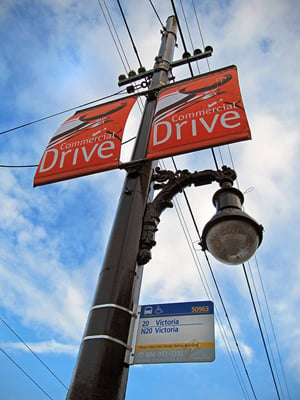
If you ever decide to walk the length -- and at least part of the breadth -- of Grandview-Woodland and you do it on a winter's day, then it pays to start out with a hearty breakfast. You can get one of those, billed as a ''meat skillet'' and served in the cast iron pan in which it is cooked, which seems both manly and befittingly industrial, arising at the corner of Powell and Commercial, where Kessel&March operates its foodstore/eatery.
Breakfast is served at the headwaters, so to speak, of Commercial Drive, the sinuous soul of Vancouver's east side and, it might be argued, one of the last hold-outs of class and conscience in a city gone mad with glass and nonsense.
Just a few short metres from my two baked eggs, ham, breakfast sausage, potatoes, baked beans, tomato, mushroom and toast is a chain link fence, several garbage cans, surveillance cameras and, on the other side of the fence, on the railway tracks, a rust-brown CN car bearing the emblem of La Commission Canadienne de Blé.
A river's job is to find its way to the sea. Commercial Drive, by contrast, flows up hill, away from the inlet to where the view is still grand but the land less wooded than when the railroad first made its way to Vancouver's shore. The port is all fenced off these days, and some of the near shore industry and chandlery has given way to huge storage lockers because apparently, in the modern economy, once we've offloaded all those goods that arrive from China in containers, our houses are no longer sufficient to accommodate the stuff we buy, so we pack it away back down near its port of entry. Self-storage is the fastest growing segment of the commercial real estate industry. Strange times.
Opposite Kessel&March on Powell is the stirring of an even newer economy, Tesla's Vancouver service centre, itself just metres away from a Hydro substation that hums the tune of a post fossil-fuel world. I've never seen a Tesla actually driven up Commercial Drive, mind you. The east side still inclines more to fixing things than to flashing them about.
Up aways on the corner of Franklin, at Storm Brewing Ltd., brewmaster James Walton is ''renovating'' though it is hard to separate what's new from what's, well, chaotic. Anyway, when an epidemic finally hits our shores, be sure to have some Black Plague Stout on hand. It might not stave off Ebola, but at 8.5 per cent alcohol by volume, drink enough of it and you won't care. Across the street, meanwhile, Sincerity Wholesale Ltd. seems to promise more than it can possibly deliver.
The first major tributary to intersect with Commercial Drive is Hastings Street. Look right to get your first glimpse of distant downtown -- and a foretaste of the eastward creep of developers like Millennium (of Olympic Village fame), who are offering up 82 units in a four-storey condominium development, Bohème, and promising ''a wonderful new neighbourhood of white brick residences, shops and restaurants in the heart of authentic Vancouver.'' I suppose if your idea of bohemianism is to live in a white brick condo on Hastings Street on the site of a previously ''authentic'' car lot, then plunking down a quarter of a million clams on a 500-square-foot box in ''Vancouver's Trendy East Village'' might be just the ticket. Fill your boots, and feed your inner gypsy.
The corner of Commercial and Hastings is also where the proletariat chariot, the No. 20 Victoria bus, turns south and begins its climb past Nick's Spaghetti House, which has fattened many an east side family for nigh on 60 years. In the parking lot a binner gives a friendly wave, while a woman with bright green hair (a real bohemian, perchance?) who lives upstairs between the NGE Convenience Store's 7UP sign and that of a happily revived York Theatre opens the door to admit a friend. Kitty-corner is the Adanac Towers -- at 12 storeys, one of the tallest buildings in the precinct, a modernist concrete tower built in the late 1970s and a precursor, perhaps, to a flood of incoming density. At three or four times the height of most apartment blocks in the area, you would think it would offend the skyscape, but just like the 12-storey Panorama Gardens up on Frances Street, its injury is more in its drab design than its brawn. Adanac Towers looks down on a stream of cyclists hithering and thithering crosstown on one of the east side's most popular bike routes, and it's here that the first of The Drive's S-bends curls up to meet Venables Street.
Just before The Drive straightens out, in the space of half a block, you can get a tattoo, a haircut, your computer repaired, stock up on medical marijuana and -- ''vibes! lubes!'' -- tool up at Womyn's Ware to apply some rotation to your sugar plum. Just around the corner, the delightfully named S&M Auto will rotate your tires, but John Le Van's rubber is strictly for the road. Opposite is Astorino's, the Red Velvet Room and the Ace of Suedes, all due for the chop if developer Daniel Boffo can get his 15-storey mixed-use tower approved, which will rehouse rather than displace the Kettle Friendship Society. Those 15 stories haven't thrilled local heritage advocates, but a well-designed development might just give a welcome fillip to the bottom end of The Drive.
'My kind of street'
It's on this corner that the first signs subscript Commercial Drive as The Drive -- as something more than just another city street. In an act of urbapomorphism, The Drive is assigned a personality, it being at the ''heart'' of Grandview-Woodland, according to the City of Vancouver, ''a collection of ethnic restaurants and food stores, coffee bars, clothing stores, and street activity (emphasis added)." In more plannerese, "The Drive is an eclectic high street with layers of rich history, a diverse array of independent shops and services, social and cultural facilities, and a thriving public life. In addition to its well-known commercial character, The Drive is also home to a number of apartments and other housing options (emphasis added)."
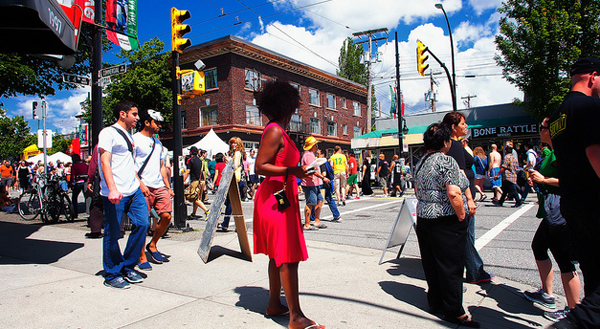
In 2011, Spacing magazine named Commercial Drive one of the top 10 public spaces in British Columbia. My friend Bruce Hill, veteran of Haight-Ashbury and a celebrated northern B.C. environmentalist, knows a thing or two about the best public spaces in the province and, on a recent visit to Vancouver, described The Drive much more lyrically than our city planners do: "What a raggedy-ass part of a street. You want diversity? Reminded me of the old Dr. Hook song, 'Freakers Ball.' Best people watching in Vancouver. My kind of street." Elsewhere, you can find comparisons that stretch as far as Greenwich Village or the Rive Gauche. Certainly, The Drive and its flanks form an ecosystem that is diverse, resilient and unique in Vancouver, and -- just as with ecosystems in the province as a whole -- under threat.
Stepping up from the corner of Venables onto The Drive proper, almost immediately I spy two of Vancouver's more Paleolithic personalities -- the opera's Charles Barber, and pseudo-socialist symphonist Bob Williams -- ''talking about funerals'' over meat and eggs and coffee at Zawa Restaurant. Specifically, they are celebrating the scholarship of the recently departed Ralph Maud, founder of Simon Fraser University's English Department and a particularly trenchant critic of ethnographer Franz Boas. Williams pauses long enough to comment on Vision Vancouver's win in the November civic elections. ''You hold your nose.''
Thedrive.ca says there are about 400 ''single location, owner operated'' stores between Venables and 13th Avenue. Like all ecosystems, The Drive's is mutable, in constant seasonal and economic flux. There is die off, as signalled by brown paper in the windows of Urban Empire that marks not just the passing of Patricia Salmond, The Drive's ''Queen of Kitsch'' who died in early 2013, but a store that didn't survive her. There is renewal, right next door where, in this case, brown paper in the windows heralds the coming of Moja Coffee, because of course The Drive needs more coffee shops. Plus ça change, as they say on the Rive Gauche, which is precisely the point. Change and growth are essential characteristics of healthy ecosystems, which thrive on the interaction of their many parts. So it is with the ecology of Grandview-Woodland.
A little farther upstream, the TV sets start, as if to remind us How Soccer Explains the World, as Franklin Foer wrote a decade ago in his ''unlikely theory of globalization.'' On The Drive, soccer's loyalties and rivalries are some of the more boisterous manifestations of the community's resistance to homogeneity. You can watch soccer at the redoubtable Portuguese Club of Vancouver, at the dubious Joe's Café, or at any of a succession of Cafés, Caffes, Caffés (and in some cases all three at the same time) whose names roll off the tongue like a language lesson: Abruzzo, Amici, Bella Napoli, Giancarlo's; plus bars like Avanti, Falconetti's, Federico's; and while it doesn't have soccer on TV, just for the sheer fun of it say La Grotta del Formaggio out loud a few times. There, you feel better already.
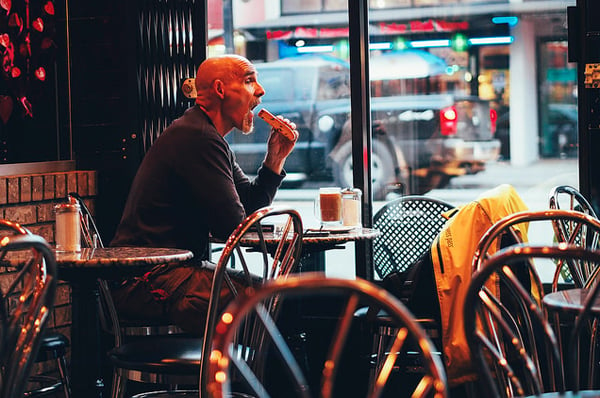
An oddity this day is that Caffe/Caffé Roma is playing NFL on its flat screens, for which it is rewarded with a single patron. Café/Caffé Calabria hosts Italian motorcycle aficionados one Tuesday night a month, meanwhile.* Prado steams up with the eager breath of its posse of entreposeurs, while at Continental Coffee some media types strike a pose of what Adam Gopnik calls ''café millennialism,'' in this case the Vancouver Sun's John Mackie waxing anxious to a couple of cashiered former CanWesters about the future of the Star Weekly/Grandview Smoke Shop sign across the street. It, like the Grandview Lanes bowling pin, is a neon rarity. JJ Bean's newer sign adds a dash of welcome colour, although the whiff of the kiff from the Jamaican patio in rear of JJ Bean -- well, remember that reference to ''street activity?'' There be it.
A couple of doors south, meantime, an exuberant new eatery, Lear Faye, opens and lasts barely six months, but next door Fadi Eid is thriving at Jamjar, doing for Lebanese food what Vikram Vij did eponymously for Indian food over near South Granville. Jamjar is a brilliant addition to The Drive's menu, which runs a pretty good gamut of international cuisine: Thai, Greek, Himalayan, Salvadoran, Italian, Indian, Japanese, Ethiopian, Belgian, Mexican, Tunisian, French, Chinese, Jamaican and various takes on whatever passes for Canadian these days. Jamjar sits at the base of the Marquee, a four-storey redevelopment of the old Van East Theatre site, where believe it or not, you can drop upwards of eight hundred large on a condo. The prices are ridiculous and the building is unlovely, but the scale of it is about right, and there are said to be more re-developments on the way in the three- to four-storey range.
Then came the towers
There's no doubting that The Drive's building stock needs a refresh. One local observer and resident, Elizabeth Murphy, recently wrote that about 50 per cent of Grandview-Woodland ''is made up of the original heritage character built prior to 1920, generally well maintained and adaptively reused as multiple-suite buildings that tend to be more affordable than new. Many streets are entirely intact with the original buildings.'' That's not always a good thing, especially when it comes to commercial buildings, and The Drive has rather more sad sack one- and two-storey stucco boxes than it needs, although it also has some terrific two- to three-storey buildings whose posture, as one architect friend observes, affects an ''Edwardian Commercial Italianate'' air (the Red Burrito is in one; so is the new Moja Coffee). Then there are outright mistakes, like Il Mercato on the corner of First Avenue, although at least it is redeemed as the home of the best pizza in town, at Lombardo's.
First Avenue is, of course, a major traffic thoroughfare. So too, East Broadway, eight blocks south. At the corner of Commercial and Broadway, the last of The Drive signs appears. While the street extends another kilometre or so, Broadway is effectively The Drive's south shore. It is here, just after crossing the Grandview Cut, that the city deems The Drive to have ended, and with it, apparently, any lingering regard for eclecticism, or any further tolerance for character. In the planning process currently underway, it is as if all bets are suddenly off once celebrations of The Drive's ecumenical nature are magically left behind.
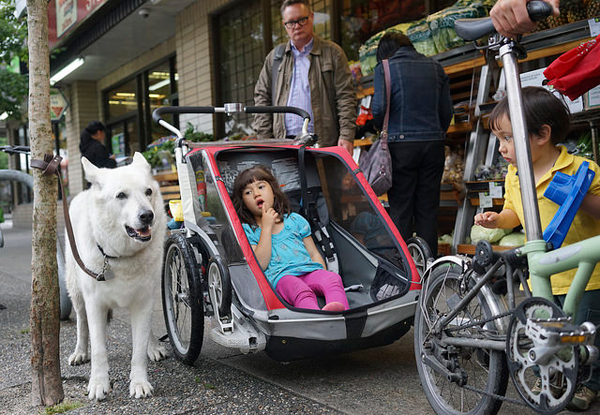
Cross over Broadway and you might as well have crossed the Rubicon. How else to explain the utter ineptitude and mindlessness with which city planners dumped a proposal into the neighbourhood 18 months ago that included a 36-storey monstrosity on the Safeway site, flanked by more podium point towers than you could poke a stick at. When Charles Campbell sought my reaction in July 2013, I said something glib in the Tyee about it being ''the urban equivalent of Enbridge's Northern Gateway. Absurd, totally out of proportion, and ultimately doomed." If anything, and even after the planners have scrambled up assurances of a better and more responsive planning process, and a lot less building mass, my views have hardened. At one point last summer I was at the Trout Lake Farmers Market and I took photos of the skyline, and then tried to imagine it with 36, or even 26 storeys of apartments jammed into the frame. While it is somewhat cartoonish, I'm delighted that someone else had the same thought and rendered it here.
Okay, so it won't look like that, but given the proximity to the precious ecosystem that makes The Drive thrive, how not to think of this as the architectural equivalent of a tarsands pipeline, or a tailings pond, or a massive dam? What's driving this urgent need to develop our corner of the world anyway?
The church of Density
It turns out that's easily answered. Just go to a Grandview-Woodland community planning meeting, like I did at the Wise Hall, and consider yourself a noviciate in a hallowed church whose true and only real god is Density. Density as Destiny. That is the susurrus that ripples through these gatherings. Andrew Pask, the planner of record on the Grandview-Woodlands file, is said to be a good planner and he seems to be a good guy, so when the number 160,000 slips from his lips, it is like a communion with the Nazareth Himself. One hundred and sixty thousand, that's how many people are moving to Vancouver between now and 2041, that's the absorptive capacity the city needs to arrive at through unquestioned fealty to Density. Thus the future of our neighbourhood, our density expressed as a formula, can be defined as mass divided by volume, where p, or density, is a function of the mass of new construction divided by the volume of people desperate enough or who, thanks to our planners and developers, are given no choice but to buy into it.
' The worshippers at the Wise Hall are invited to be duped towards choices, or if not choices then biases about what is most important to their sense of community health and vitality. These are represented by adhesive coloured dots we get to place on Post-it notes on the wall, where density and transportation compete for our attention with things like arts and culture. Density wins, of course, not because it is more important than other issues but because the threat of it crowds out everything else. We are ostensibly there to ''learn how the city is making Grandview-Woodland a more vibrant, liveable, and sustainable community,'' but we are actually there to give cover to a process of parsing out our share of the burden of absorbing more density. Just like a pipeline planning process, the tables are tilted towards getting us to Yes, to quote the rebarbative framing that Premier Christy Clark employs to sell her development vision for B.C.
Not everyone is easily converted. At my table, a man who looks to be in his 50s, Gordon, a thoroughly rational and reasonable chap who has lived in the area for more than 20 years, points out that his street has been absorbing more density for years. There are now cars packed along the street where before it was a cinch to park at any hour. There are way more people now, way more volume that has been taken up without having to turn the 'hood into another Metrotown's worth of mass. No need, yet, for vertical policing, no cubiculosis, no inexorable jacking of commercial rents to drive out all that ''authenticity.'' No towers.
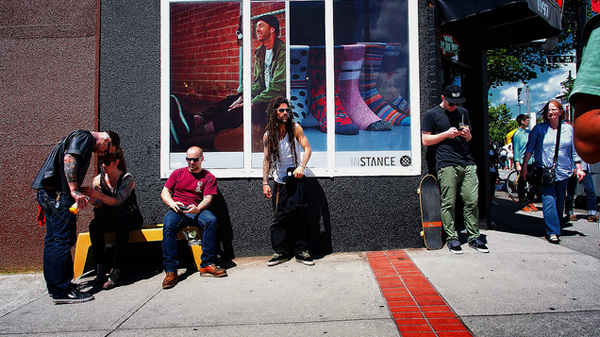
His gently subversive view is that Grandview-Woodland is no more duty bound to ''absorb'' its Vision-defined share of Vancouver's population than our northern First Nations should be required to have a pipeline rammed through their territories. The fact is, Grandview-Woodland already does its bit. We already suck up a huge amount of the city's mobile density by eating and feeding back to the suburbs the daily masses of traffic that clog Powell and Hastings and Victoria and First and Broadway and 12th. We already host a SkyTrain hub at Broadway and Commercial that is among the busiest interchanges on the continent. We play our part. I'd hazard a guess that folks would tolerate 12, maybe 15 storeys on the Safeway site, quickly dropped to eight to six to four storeys so as to fold gently back into the prevailing heights along The Drive. But I don't know a single soul who trusts the city on this. The sad thing is that many people, like me, are in favour of density, but this administration and its sponsors have so distorted what that means in Vancouver that our default assumption is that density is a stalking horse for more glass and nonsense.
When the faulty tower balloon was floated and quickly deflated, the backlash in the neighbourhood was palpable. Months later, Bob Williams wasn't the only one to hold his nose when time came to vote last fall. Even Mayor Gregor Robertson seemed to catch an 11th-hour whiff of his own political mortality, abjectly apologizing for not having listened when it came to density and bike lanes, in particular. "I am going to adjust," said our chief magistrate. Maybe so, but now that we are in the municipal fallow season, the density question has moved back inside among the experts. There is a nimbus of dense determinism that has settled around our planners once again, and I think it is time for some righteous noise to rise up from the 'hood again.
Commercial Drive, The Drive -- all its contradictions, and all its glorious complexities comprise the vertebrae of a Vancouver that is fading fast, but is worth fighting for still. This is where we live. This is how we live. The Pied Planners of 12th & Cambie want to get us to Yes. It's time for us to show some spine, and get them to No.
*Story clarified March 16 at 1:45 p.m. ![]()
Read more: Municipal Politics, Urban Planning + Architecture
















Tyee Commenting Guidelines
Comments that violate guidelines risk being deleted, and violations may result in a temporary or permanent user ban. Maintain the spirit of good conversation to stay in the discussion.
*Please note The Tyee is not a forum for spreading misinformation about COVID-19, denying its existence or minimizing its risk to public health.
Do:
Do not: